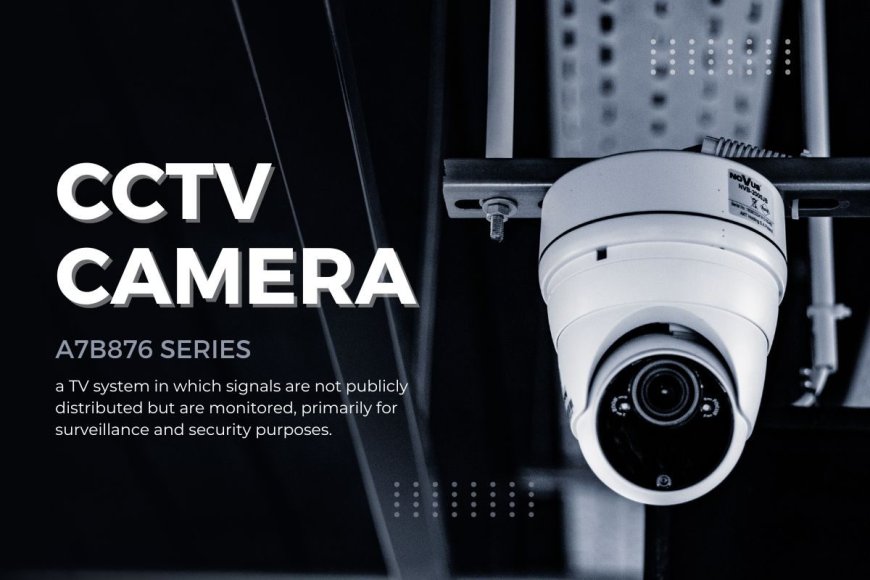Top CCTV Camera Types & Uses: Smart Surveillance Guide
Explore the most popular CCTV camera types, their smart uses, and how to choose the best system for your needs. Full guide with expert tips and FAQs included.

Top CCTV Camera Types & Uses: Smart Surveillance Guide
1. Why CCTV Cameras Are a Modern Necessity
Todays fast-paced world demands reliable security solutions, and CCTV cameras are at the core of smart surveillance. Whether it's for your home, office, or commercial space, these cameras offer constant monitoring, crime deterrence, and peace of mind. They're not just reactive tools anymoretheyre proactive eyes that alert, record, and often integrate with smart devices. With the rising need for safety, both in urban and rural areas, investing in a good CCTV system has become more of a necessity than a luxury.
2. Bullet CCTV Cameras Perfect for Long-Range Viewing
Bullet cameras are highly visible and ideal for long-range surveillance. Theyre typically mounted on walls or ceilings and are used both indoors and outdoors. Due to their cylindrical shape, they offer a wide field of view and often come with weatherproof designs. Theyre commonly used in parking lots, warehouses, and around building perimeters. These cameras can act as a strong visual deterrent for potential intruders.
3. Dome Cameras Best for Discreet Indoor Surveillance
Dome cameras are designed to blend with their surroundings. Shaped like a dome, they are often installed on ceilings and are perfect for indoor use. The camera's structure makes it difficult to see which direction it is pointingadding to its effectiveness. These are best used in retail stores, restaurants, or any place where subtle surveillance is needed. Many dome cameras also come with vandal-proof housings.
4. PTZ Cameras Ultimate Control and Flexibility
PTZ (Pan-Tilt-Zoom) cameras are known for their remote-controlled features, allowing users to move the camera up/down, left/right, and zoom in/out. They are perfect for large areas like stadiums, malls, or city surveillance. One PTZ camera can replace multiple fixed cameras, thanks to its wide coverage. They're ideal when live monitoring is necessary since operators can actively track movements.
5. IP Cameras High-Resolution and Smart Monitoring
IP (Internet Protocol) cameras deliver high-resolution video and connect through a network. Theyre a step ahead of analog cameras in terms of clarity and integration. One of the key benefits is remote accessibilityyou can view footage from anywhere using a smartphone or laptop. With the rise in smart home integration, IP cameras are now a standard choice. You can find various models and specifications at this reliable surveillance camera provider.
6. Wireless CCTV Cameras Easy Setup, No Cables
Wireless cameras are excellent for DIY installations. They dont require extensive cabling, which makes them easy to install and relocate. Many come with cloud storage options and smart app integration. Ideal for rental homes or small businesses, wireless cameras are both practical and stylish. Despite being wireless, some still need a power source, so placement planning is essential.
7. Outdoor CCTV Cameras Built to Withstand the Elements
Designed to endure extreme weather conditions, outdoor CCTV cameras are made with durable, weather-resistant materials. They often include features like infrared night vision, motion detection, and high-definition recording. These cameras protect your propertys external pointsdriveways, fences, garagesand ensure surveillance continues even in rain or snow. Look for models with wide dynamic range and anti-glare features for best results.
8. Indoor Cameras Smart Monitoring for Inside Spaces
Indoor cameras are typically smaller and more compact than outdoor models. They're perfect for keeping an eye on your living room, kids' rooms, or office interiors. Many come with motion sensors and two-way audio. Some advanced indoor units now integrate with AI to recognize familiar faces and alert on unusual activity. These are ideal for smart home environments.
9. Day/Night CCTV Cameras 24/7 Protection
Day/Night cameras are built for continuous use. They can capture clear video footage in both bright daylight and low-light conditions. These cameras usually feature infrared (IR) technology, which helps them see in complete darkness. Suitable for locations that need round-the-clock surveillance like banks, gas stations, and entrances, these cameras ensure nothing escapes your view.
10. Thermal Imaging Cameras Advanced Surveillance
Thermal cameras use heat signatures to detect movement. They are highly effective in zero-visibility conditions such as fog, smoke, or complete darkness. These cameras are used in high-security zones like military bases, airports, and critical infrastructure. Although more expensive, their utility in identifying threats invisible to traditional cameras makes them indispensable in sensitive setups.
11. Smart Features to Look for in CCTV Cameras
Modern CCTV systems come with intelligent features that enhance usability. These include motion detection, facial recognition, license plate detection, and two-way communication. Integration with mobile apps, cloud storage, and AI analytics has elevated the capabilities of CCTV far beyond simple recording. Some models also feature built-in sirens and floodlights for active deterrence.
12. Choosing the Right Camera for Your Needs
Choosing the best CCTV camera depends on your specific requirementslocation, lighting conditions, resolution, and budget. For instance, a home may benefit from a combination of indoor dome cameras and outdoor bullet cameras. For large premises, a PTZ or thermal camera may be ideal. To explore a broad collection of cameras suitable for different environments, check out this camera comparison and buying guide.
13. Installing Your CCTV Camera System
Installation varies based on camera typewired setups require more planning, while wireless ones are more flexible. Professional installation ensures optimal positioning, especially for cameras that need precise angles. If you prefer to do it yourself, many systems come with user-friendly manuals. Always consider power sources, network access, and visibility when positioning cameras.
14. Maintenance Tips for Longevity
Like all electronic devices, CCTV systems require regular upkeep. Cleaning lenses, checking cables, updating firmware, and testing recordings are all part of routine maintenance. Outdoor cameras should be inspected for weather damage or obstruction. Make sure you also check cloud or storage capacity regularly to avoid missed footage.
15. Best Performing Camera Recommendation
If you're searching for a top-tier device, consider the Dahua 8MP Starlight IP Camera. Known for its low-light performance and crystal-clear resolution, it's ideal for both home and business users. With advanced AI features and robust construction, this camera offers superior security without compromise.
FAQs
Q1: What is the best CCTV camera for home use?
A combination of dome cameras for inside and bullet cameras for outdoors works best for homes.
Q2: Do I need internet for a CCTV system to work?
Not always. Wired systems can function without internet, but youll need it for remote access or cloud storage.
Q3: How many CCTV cameras do I need?
This depends on property size. Small homes may need 23, while large businesses could need over 10.
Q4: Can CCTV cameras record audio too?
Yes, many modern systems have built-in microphones, but audio recording laws vary by region.
Q5: Are wireless CCTV cameras reliable?
Yes, especially with strong Wi-Fi. Theyre easy to install and great for flexible setups.
Q6: What is IR night vision in CCTV?
Its a feature that allows cameras to capture footage in darkness using infrared technology.


































